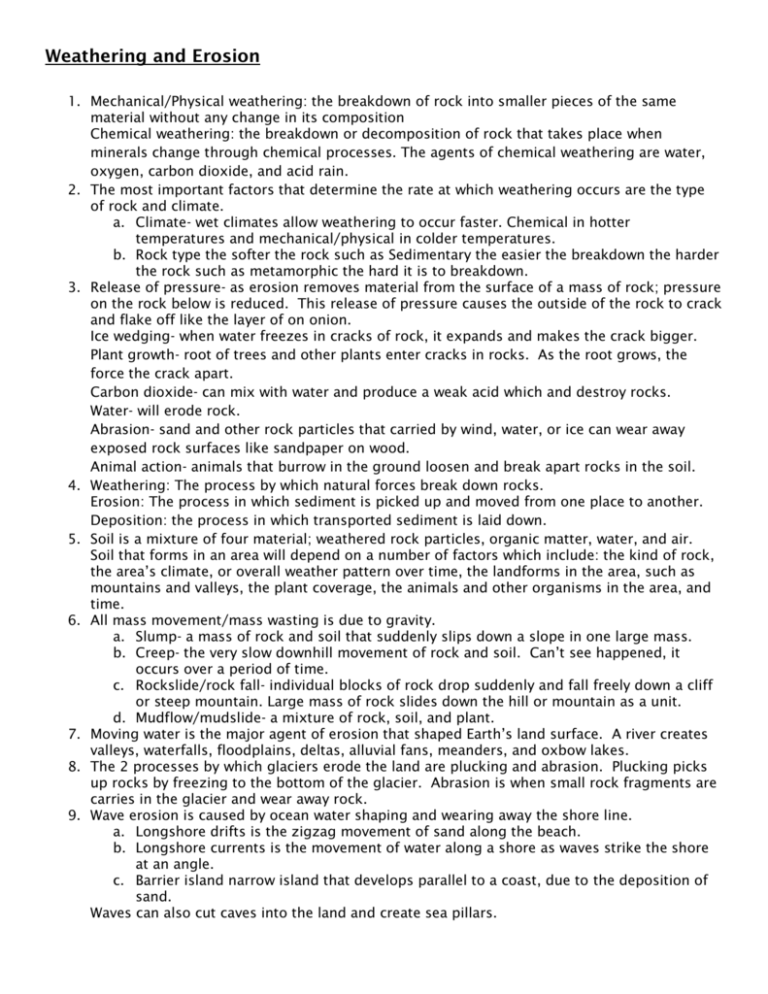Weathering and Erosion Mechanical/Physical weathering: the
advertisement

Weathering and Erosion 1. Mechanical/Physical weathering: the breakdown of rock into smaller pieces of the same material without any change in its composition Chemical weathering: the breakdown or decomposition of rock that takes place when minerals change through chemical processes. The agents of chemical weathering are water, oxygen, carbon dioxide, and acid rain. 2. The most important factors that determine the rate at which weathering occurs are the type of rock and climate. a. Climate- wet climates allow weathering to occur faster. Chemical in hotter temperatures and mechanical/physical in colder temperatures. b. Rock type the softer the rock such as Sedimentary the easier the breakdown the harder the rock such as metamorphic the hard it is to breakdown. 3. Release of pressure- as erosion removes material from the surface of a mass of rock; pressure on the rock below is reduced. This release of pressure causes the outside of the rock to crack and flake off like the layer of on onion. Ice wedging- when water freezes in cracks of rock, it expands and makes the crack bigger. Plant growth- root of trees and other plants enter cracks in rocks. As the root grows, the force the crack apart. Carbon dioxide- can mix with water and produce a weak acid which and destroy rocks. Water- will erode rock. Abrasion- sand and other rock particles that carried by wind, water, or ice can wear away exposed rock surfaces like sandpaper on wood. Animal action- animals that burrow in the ground loosen and break apart rocks in the soil. 4. Weathering: The process by which natural forces break down rocks. Erosion: The process in which sediment is picked up and moved from one place to another. Deposition: the process in which transported sediment is laid down. 5. Soil is a mixture of four material; weathered rock particles, organic matter, water, and air. Soil that forms in an area will depend on a number of factors which include: the kind of rock, the area’s climate, or overall weather pattern over time, the landforms in the area, such as mountains and valleys, the plant coverage, the animals and other organisms in the area, and time. 6. All mass movement/mass wasting is due to gravity. a. Slump- a mass of rock and soil that suddenly slips down a slope in one large mass. b. Creep- the very slow downhill movement of rock and soil. Can’t see happened, it occurs over a period of time. c. Rockslide/rock fall- individual blocks of rock drop suddenly and fall freely down a cliff or steep mountain. Large mass of rock slides down the hill or mountain as a unit. d. Mudflow/mudslide- a mixture of rock, soil, and plant. 7. Moving water is the major agent of erosion that shaped Earth’s land surface. A river creates valleys, waterfalls, floodplains, deltas, alluvial fans, meanders, and oxbow lakes. 8. The 2 processes by which glaciers erode the land are plucking and abrasion. Plucking picks up rocks by freezing to the bottom of the glacier. Abrasion is when small rock fragments are carries in the glacier and wear away rock. 9. Wave erosion is caused by ocean water shaping and wearing away the shore line. a. Longshore drifts is the zigzag movement of sand along the beach. b. Longshore currents is the movement of water along a shore as waves strike the shore at an angle. c. Barrier island narrow island that develops parallel to a coast, due to the deposition of sand. Waves can also cut caves into the land and create sea pillars. 10. Wind erosion shapes the land by the wind blowing particle of sand. This can create dunes, which is a mound of sand built up by wind. It can also cause abrasion which wears away rock.









